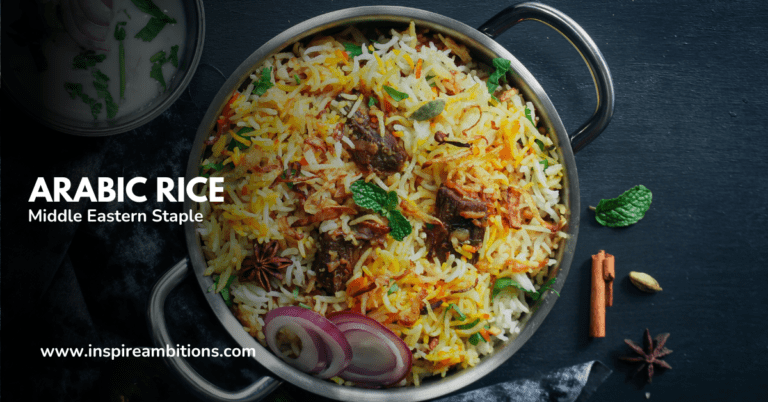আরবি ফতুশ সালাদ - একটি স্বাস্থ্যকর এবং স্বাদযুক্ত আনন্দ
Arabic fattoush salad is a delightful and nutritious dish to add to your culinary experience. Originating from Northern Lebanon, this vibrant, colourful salad is a staple in Middle Eastern cuisine and can often be found served as part of a mezza, which consists of numerous small dishes to be shared among friends and family.
As a must-try for those new to Arabic cooking, you will not only enjoy its mouthwatering taste but also reap the health benefits of its fresh ingredients.
The primary component of fattoush is pita bread, typically toasted or fried to give it a crunch that contrasts beautifully with the fresh vegetables and herbs found in the salad.
In-season ingredients such as lettuce, tomatoes, cucumbers, onions, and parsley are common, along with the unique addition of ground sumac and pomegranate molasses for a zesty, tangy flavour. This versatile salad can be easily adapted based on your preferences and the seasonal availability of produce, making it an ideal dish to prepare all year round.
As you embark on your journey to prepare a delicious fattoush salad, remember to source quality ingredients and be open to experimenting with different combinations. With its refreshing taste, simple preparation, and nutritious qualities, it will soon become a favourite addition to your culinary repertoire.
History of Fattoush Salad
Fattoush salad is a flavoursome concoction that originated in Northern Lebanon, a region famous for its agricultural production. The farmers from this area faced a dilemma about how to utilise their stale flatbread which led them to create this delightful dish. They deep-fried the leftover pita scraps in olive oil, adding extra flavour and crunch to the salad.
The salad itself is a blend of mixed greens, vegetables such as radishes and tomatoes, and toasted or fried pieces of khubz (Arabic flatbread). Fattoush is immensely popular in communities within the Levant region and has gained recognition worldwide for its unique taste and resourcefulness.
One of the key components in a traditional Fattoush salad is the tangy, flavourful dressing. Sumac, a deep red spice with a sour taste, is used widely in মধ্যপ্রাচ্যের রান্না and plays a vital role in salad dressing.
The dried and powdered fruits of the sumac flowering plant from the Anacardiaceae family not only enhance the zesty dressing but are also sprinkled over the bread and salad before it is toasted.
When making a Fattoush salad, you can expect a colourful and delicious dish, rich in history and resourcefulness. By following an authentic Lebanese recipe, you can create this well-seasoned concoction, combining crispy fried pita bread with seasonal vegetables and a zesty Mediterranean dressing made from sumac.
Ingredients Necessary
To make a delicious Arabic Fattoush Salad, you will need the following ingredients:
- পিঠা রুটি: 2 small (4-inch) pita bread, torn into pieces. You will later fry these in vegetable oil to add a crispy texture to your salad.
- শাকসবজি: Gather a variety of vegetables for a crisp and fresh base. This includes 1 large English cucumber, finely diced; 3 cups halved grape tomatoes; ½ red onion, finely diced; and (optionally) radishes, and bell pepper.
- Fresh herbs: Enhance the flavour with 3⁄4 cup chopped Italian parsley and ¾ cup chopped fresh mint. These herbs add a bright freshness to the salad that complements the vegetables perfectly.
- Lettuce: You can use romaine or iceberg lettuce as the main green leafy component of the salad. Some people also like to add spinach for an extra nutritional boost.
- Dressing: To bring everything together, mix 2 tablespoons of extra-virgin olive oil with 1 tablespoon of fresh lemon juice. You may adjust the quantities to your taste.
While these are the basic ingredients found in a Fattoush Salad, other optional ingredients worth considering include purslane leaves, green onions, and additional spices such as sumac or dried mint. Remember to use only fresh and high-quality ingredients for the best-tasting salad. Enjoy!
Arabic Fattoush Salad Preparation Steps
এখানে.
Preparing the Vegetables
To prepare your Arabic Fattoush Salad vegetables, start by washing them thoroughly. Next, finely dice 1 large English cucumber and halve 3 cups of grape tomatoes. Additionally, chop ¾ cup of Italian parsley and, if using, slice your choice of lettuce (romaine or iceberg) into bite-sized pieces.
Mixing the Dressing
In a separate bowl, mix the dressing by combining 4 teaspoons of ground sumac soaked in 4 teaspoons of warm water for 15 minutes with 3 tablespoons of fresh lemon juice, 2 tablespoons of pomegranate molasses, and 2 small crushed garlic cloves.
Taste the dressing and adjust the tanginess by adding more lemon juice or pomegranate molasses if desired.
Combining the Salad
In a large mixing bowl, combine the prepared vegetables, lettuce, and parsley. Pour the dressing over the salad and use your hands or salad utensils to gently mix the ingredients until everything is well coated. Let the salad sit for a few minutes to allow the flavours to meld.
Baking the Bread
While the salad is resting, preheat your oven or a skillet to medium heat. Tear 2 small (4-inch) pita bread into bite-sized pieces and toss them in 1 tablespoon of vegetable oil. Spread the oiled pita pieces evenly on a baking sheet or directly onto a skillet, and season them generously with a pinch of salt and a dusting of sumac.
Toast the pita bread until it’s golden brown and crispy, which should take approximately 5 minutes. Once toasted, remove the bread from the oven or skillet and let it cool. Finally, gently fold the toasted pita pieces into the salad just before serving to maintain their crispiness. Enjoy your freshly made Arabic Fattoush Salad!
Recommended Serving Suggestions
Fattoush salad is a versatile and flavourful dish that can easily be adapted to suit your preferences. Here are a few serving suggestions to get the most enjoyment out of this delightful Middle Eastern salad.
1. Choose the right vegetables:
Feel free to add or remove vegetables according to your taste. Cucumbers and tomatoes are traditional choices, but you can also include radishes, green onions, or even slices of bell pepper for a burst of colour and flavour.
2. Use fresh herbs:
Parsley and mint are essential for that authentic Arabic taste, and when it comes to herbs, fresher is always better. You can use them sparingly or generously, depending on your preference.
3. Make it complete with pita:
Fattoush derives its name from the Arabic word “fatteh”, which refers to bread crumbs. To stay true to its origins, be sure to include some torn or cubed pieces of pita bread in your salad. You can lightly fry the pita in oil, or for a healthier option, toast them in the oven.
4. Dress it up:
A zesty vinaigrette is key for giving Fattoush its uniquely complex flavour. Mixing olive oil, lemon juice, and a pinch of sumac spice creates a well-balanced dressing that will take your salad to the next level.
5. Add a protein option:
While not traditional, you can easily make Fattoush a more substantial meal by adding protein. Grilled chicken or lamb, chickpeas, feta cheese, or even avocado can be delicious additions.
These serving suggestions should help you create a Fattoush salad that’s perfect for your স্বাদ কুঁড়ি. Remember, the beauty of a dish like this is in its adaptability, so don’t be afraid to get creative and make it your own. Enjoy!
Variations of Fattoush Salad
There are numerous variations of Fattoush Salad depending on the region in the Middle East. In this section, we will discuss three popular styles: Lebanese, Syrian, and Palestinian.
Lebanese Style
ভিতরে Lebanese Fattoush Salad, you’ll find well-seasoned fried pita bread combined with seasonal vegetables. The salad is tossed in a zesty sumac Mediterranean dressing. Key ingredients typically include cucumbers, tomatoes, radish, green onions, and fresh herbs such as parsley and mint.
The salad gets its distinct flavour from a simple, zesty vinaigrette and a generous dash of sumac spice 1 2.
Here are some distinctive features of Lebanese-style fattoush:
- Fried pita bread
- Sumac Mediterranean Dressing
- Herbs like parsley and mint
Syrian Style
Syrian Fattoush Salad is quite similar to the Lebanese version in terms of ingredients; however, there may be slight variations in the seasoning and preparation. For example, the pita bread might be baked instead of fried, resulting in a lower-fat option.
The dressing can also include pomegranate molasses to add a tangy and sweet twist to the salad 3.
Differences in Syrian-style Fattoush may include:
- Baked pita bread
- Pomegranate molasses dressing
Palestinian Style
দ্য Palestinian Fattoush Salad often features a wider variety of vegetables. Adding ingredients like red bell peppers, jalapenos, and olives gives this version a unique twist.
Palestinian-style fattoush may also include traditional sour sumac dressing or fresh lemon garlic dressing. Fried or baked pita bread is still an essential component of this variation 4.
Here are some standout features of Palestinian Fattoush:
- Various vegetables, including bell peppers, jalapenos, and olives
- Sour sumac dressing or lemon garlic dressing
স্বাস্থ্য সুবিধাসমুহ
Fattoush is a popular Levantine salad that has many nutritional benefits. This salad is made from a combination of toasted or fried pieces of khubz (Arabic flat bread) with mixed greens and vegetables such as radishes and tomatoes.
One of the main advantages of Fattoush is its high fibre content, contributing to a healthy digestive system. Consuming a diet rich in fibre is essential for maintaining a well-balanced diet.
The salad is also packed with various vitamins and minerals, making it an excellent addition to your daily meals.
The ingredients in Fattoush provide essential nutrients to your body.
For instance, the presence of vitamin A supports good vision and immune health, while vitamin C assists with collagen production and immune function. Vitamin K, on the other hand, plays a crucial role in blood clotting and bone health.
Another notable aspect of Fattoush is its relatively low-calorie count. With less than 200 calories per serving, it is a great option if you are looking to manage your weight without sacrificing taste or nutritional value.
Additionally, the salad’s healthy fats aid your body in absorbing essential nutrients more efficiently.
In summary, incorporating Fattoush into your meal plan can provide numerous health benefits. Its combination of nutritional value, low-calorie count, and delicious taste makes it a perfect addition to any diet.
Pairings
When enjoying a delicious Arabic Fattoush salad, you may be looking for the perfect pairings to elevate your dining experience. With its colourful blend of vegetables, crispy pita, and tangy dressing, Fattoush can be complemented by a variety of dishes and drinks.
Firstly, consider pairing your Fattoush salad with some classic Middle Eastern dishes. As a staple dish on the mezza table, Fattoush goes well with other meze options such as hummus, baba ganoush, and stuffed grape leaves.
You can also serve your salad alongside grilled meats, like shish kebabs or chicken shawarma, to ভারসাম্য out the rich flavours with some freshness.
For beverages, Fattoush pairs nicely with several refreshing drinks. A glass of chilled white wine, such as a Sauvignon Blanc or a Riesling, can complement the salad’s acidity and vibrant flavours.
Alternatively, non-alcoholic options like mint lemonade or sparkling water with a twist of lemon can provide a delightful and thirst-quenching accompaniment.
In terms of side dishes, consider serving your Fattoush with some warm pita bread, perfect for dipping in the tangy dressing and scooping up those delicious vegetable bites. Rice dishes, such as mujadara or pilaf, can also complement the salad and provide a more filling meal option.
Remember, the key to the perfect Fattoush pairing is to complement the salad’s lively flavours and textures without overshadowing them.
By choosing the right dishes and drinks to accompany your Arabic Fattoush salad, you can create an enjoyable and satisfying culinary experience for yourself and your guests.
Storage and Leftovers
Storing your Fattoush salad is relatively easy. To keep the salad fresh, simply follow these steps:
- If you have any leftover salad, try to separate the pita bread from the rest of the ingredients. This will prevent the bread from becoming excessively soggy.
- Place the remaining salad ingredients in an airtight container. Seal the container and store it in the refrigerator. This will help maintain the crispness and freshness of the vegetables.
- Store the pita bread separately, preferably in an airtight bag, to keep it from becoming stale.
Your Fattoush salad can be stored in the refrigerator for up to 2 days. Beyond that, the quality and texture of the vegetables may start to deteriorate.
Keep in mind that salads containing tomatoes may become soggy over time, so it’s best to consume the leftovers within a day if possible.
To enjoy your leftovers, toss the salad with the stored pita bread and a little drizzle of olive oil if needed. This will help rejuvenate the flavours and ensure you have a delicious Fattoush salad once more.
In summary, by simply separating the pita bread from the salad and storing both in airtight containers, you’ll be able to enjoy your Fattoush leftovers for a day or two. Just remember to consume the salad within a reasonable time to prevent any decline in taste or quality.
সচরাচর জিজ্ঞাস্য
What is Fattoush Salad?
Fattoush is a popular Arabic salad originating from the Middle East, specifically Lebanon. It is a colourful and flavourful dish consisting of fresh vegetables, herbs, and crispy pita bread, all tossed in a lemony garlic dressing.
Fattoush is commonly served as part of a meze spread or as a side dish to a main meal.
What are the main ingredients in Fattoush Salad?
The key ingredients in a traditional Fattoush salad include:
- Lettuce (typically romaine or iceberg)
- Fresh parsley
- Tomatoes (large varieties like Roma or vine, but cherry or grape tomatoes can be used too)
- Cucumbers
- Radishes
- Green onions
- Mint leaves
- Pita bread (toasted or baked until crispy)
The lemony garlic dressing usually consists of lemon juice, olive oil, garlic, and sumac, a tangy spice common in Middle Eastern cuisine.
How do you make Fattoush Salad?
To make Fattoush Salad, follow these simple steps:
- Prepare your vegetables: Wash and chop the lettuce, parsley, tomatoes, cucumbers, radishes, green onions, and mint leaves.
- Make the dressing: Whisk together lemon juice, olive oil, crushed garlic, and sumac.
- Toast or bake the pita bread until crispy, then break into bite-sized pieces.
- In a large bowl, combine the prepared vegetables and herbs. Toss with the dressing until well coated.
- Add the crispy pita bread pieces to the salad just before serving, and enjoy your delicious Fattoush Salad.
Can I make any substitutions or additions to the salad?
Absolutely! Fattoush is a versatile salad that can be easily adapted to suit your tastes or dietary needs. Some common variations include:
- Adding other vegetables such as bell peppers, carrots, or spring onions
- Replacing the lettuce with spinach or another leafy green
- Using gluten-free pita bread for a gluten-free version
- Adding crumbled feta cheese or olives to the salad for extra flavour
Feel free to get creative and personalise your Fattoush Salad to your liking.
পাদটীকা
- Lebanese Fattoush Salad {Authentic Recipe} – FeelGoodFoodie ↩
- Fattoush Salad Recipe | The Mediterranean Dish ↩
- Our 6 Best Fattoush Salad Recipes ↩
- Arabic Fattoush Salad – Allrecipes ↩






